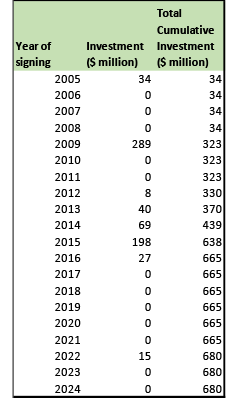Bhutan
Bhutan is a founding member of the SASEC Program, joining with Bangladesh, India, and Nepal in 2001 to form this project-based partnership. Maldives and Sri Lanka became full members of SASEC in May 2014, following several years as active observers.
Bhutan's Thirteenth Five Year Plan for 2024-2029 aims to ensure inclusive growth by pursuing strategic objectives in the areas of economic development, social development, security, and governance. The plan aims to help Bhutan become a high-income country driven by innovation and sustainability by 2029. The plan also aims to foster regional and international cooperation to help drive sustainable growth.
SASEC Projects in Bhutan
Since 2003, the Government of Bhutan has signed 10 ADB-financed SASEC investment projects worth $680.29 million.
In addition to projects, ADB-financed technical assistance has supported SASEC investment projects in Bhutan, regional cooperation forums and knowledge-sharing initiatives, and pilot projects since 2001. A total of 20 national technical assistance projects (cumulative worth over $22.76 million) have assisted Bhutan in project preparation, strategic planning, and capacity building.
Trade Snapshot
Direction of Intraregional Trade
The value of Bhutan's merchandise exports and imports trade with other SASEC countries, using International Monetary Fund data from 2025, is captured in the tables below.
Bhutan's top import source in the SASEC subregion is India, with imported goods valued at over $3.8 billion. Bangladesh exported goods to Bhutan worth $13 million while Nepal exported goods to Bhutan valued at $9 million.
Bhutan's top export destination in the SASEC subregion is India, with exported goods from Bhutan valued at $781 million. It exported goods to Nepal worth $5 million and to Bangladesh worth $3 million.
Bhutan Trade - Import
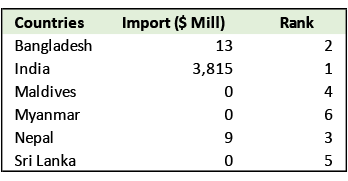 Source: IMF Direction of Trade Statistics via ARIC Database, accessed June 2025
Source: IMF Direction of Trade Statistics via ARIC Database, accessed June 2025
Bhutan Trade - Export
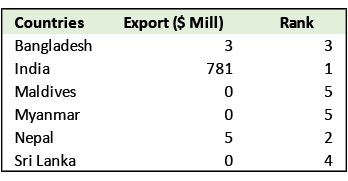 Source: IMF Direction of Trade Statistics via ARIC Database, accessed June 2025
Source: IMF Direction of Trade Statistics via ARIC Database, accessed June 2025
Logistics Performance Index (LPI)
Bhutan registered an overall LPI score of 2.9 in 2023, improving on its 2018 score of 2.17. Bhutan registered improved scores in most categories, getting its highest score in customs at 2.7, resulting in an overall 2023 rank of 97 out of 139 economies.
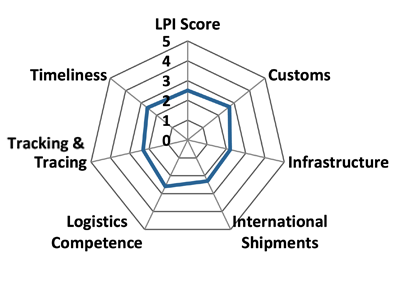
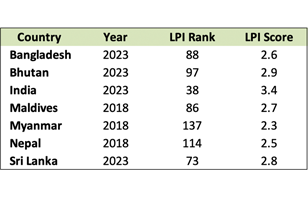

Source: World Bank LPI (accessed May 2023)
Note: The LPI overall score reflects perceptions of a country's logistics based on six core dimensions: (i) efficiency of customs clearance process, (ii) quality of trade- and transport-related infrastructure, (iii) ease of arranging competitively priced shipments, (iv) quality of logistics services, (v) ability to track and trace consignments, and (vi) frequency with which shipments reach the consignee within the scheduled time. The scores for the six areas are averaged across all respondents and aggregated to a single score using principal components analysis. A higher score indicates better performance.

Economic Outlook
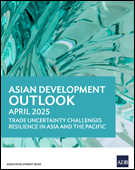
Gross domestic product (GDP) in Bhutan is estimated to grow by 8.5% in fiscal year (FY) 2025 behind expansion in industry and hydroelectric production, while GDP growth is estimated at 6.0% in FY2026. Inflation in Bhutan is projected at 3.4% in FY2025 due to the continued rise in food prices tempered by a moderation in fuel prices. Inflation is projected at 3.5% in FY2026.
Source: Asian Development Outlook April 2025 (ADB)
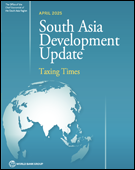
Bhutan’s real GDP is estimated to grow by 6.6% in FY2024-2025 behind a construction sector buoyed by a planned hydropower project, while growth is estimated at 7.6% in FY2025-2026. Growth will be offset by the slower-than-projected progress of the country’s agricultural transition to export-oriented agribusiness.
Source: South Asia Development Update April 2025 (WB)


